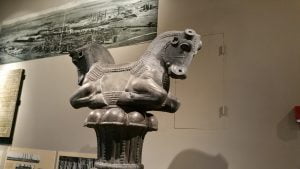
Columns were an important part of ancient architecture and often portrayed a message, a symbol.
In ancient Persepolis, there were four columns which carried the ceiling of a small palace, called the Gate of All Nations or the Gate of Xerxes. Each column had a pair of twin bulls resting on top of it, which were used to hold the beams for the ceiling.
Two massive images of bulls were also on either side of the western entrance and two massive images of lamassu (a winged man-bull) were on either side of the eastern doorway.
Darius the Great, king of Persia, began this massive building project and it continued under his successors, Xerxes and Artaxerxes I.
Darius was king at the time when Daniel served as a president and was thrown into the lion’s den. (Daniel 6)
Xerxes (a.k.a. Ahasuerus) was the king we read about in the book of Esther, whom she married.
Susa, where Esther’s story occurred, is about 400 miles northwest of Persepolis. It’s also where Darius built an audience hall in his palace that was 128,000-square-miles and had thirty-six columns, with the same double bulls holding up the roof.
While the bulls were symbols of the strength of the king and his kingdom and the lamassu were symbols of protection, Persepolis was destroyed by Alexander the Great in 330 BC.
It’s amazing to think back on the incredible, Biblical history during the time period that these columns would have stood. Did Daniel wander among them in the audience hall? Did Esther gaze at their splendor in the palace?
The remains of these buildings are magnificent and one can only imagine how beautiful they must have been at the time.
Today, there are several museums where we can find portions of these columns, including the Louvre in Paris, France, and the Oriental Institute Museum in Chicago, Illinois.
Resources:
https://toursofiran.com/blog/the-gate-of-all-nations/
https://www.khanacademy.org/humanities/ap-art-history/ancient-mediterranean-ap/ancient-near-east-a/a/persepolis
https://www.nytimes.com/2019/03/12/arts/persian-collections-louvre-susa.html